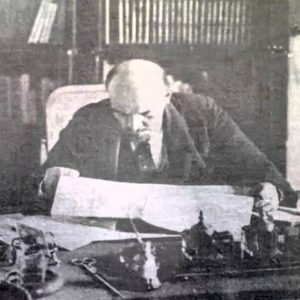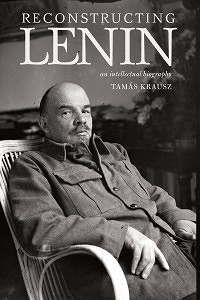Reconstructing Lenin: An Intellectual Biography
552 pp, $34 pbk, ISBN 9781583674499
By Tamás Krausz
Reviewed by Annamária Artner in Science & Society, pp 315-18, vol. 82, no. 2, April 2018
Since the collapse of Eastern European “socialism” and the Soviet Union, the prospect to transcend capitalism has been lost in obscurity.
However, what happened once can happen again, and “since the ‘end of history’ did not occur in 1989, one need not be a prophet to foresee that the need for the revolutionary salvation of the world will arise again” (Krausz, 2015, 364). The ruling class would like to forget this possibility. Any talk about historical periods when the balance of class struggle tilted in favor of the exploited is perceived as dangerous for the exploiters, especially if their position is shaken by an economic crisis, and the consequent dissatisfaction of a large part of the population, like today. This makes Tamás Krausz’s book about Lenin particularly relevant. The first Hungarian edition was published in 2008, followed by a Russian edition in 2011 and publication in the United States in 2015. The exceptional value of the book has been recognized by the Deutscher Memorial Prize also in that year.
The novelty of the book is its genre. It is neither a historical book about Lenin’s life nor a summary of Lenin’s theoretical work, although it contains both. Krausz reconstructed Lenin’s most important theses (which have relevance for today as well) by showing how they were hammered out by historical processes, through political struggles, theoretical debates, by the concrete questions and the concrete answers to these in the process of the Revolution. This non-conventional reconstruction of the past gives an understanding of how history formed Lenin and vice versa. In this way, the reader finds him/herself in the middle of the history and may ponder together with Lenin upon the best actual and theoretical answers that should be given to the arising socio-political problems.
This extensive book is sophisticated, and well sourced, but is not an easy read, in either Hungarian or English. Fortunately, the author helps the reader in many ways. He introduces Lenin’s life in the first chapter (“Who was Lenin?”), and then positions this chronology to describe the political and theoretical debates and struggles as well as Lenin’s role in them. This order makes the analysis much easier to follow.
The combined history of the actual socio-political context and the evolution of Lenin’s theory begins with Russian capitalism at the turn of the 19th and 20th centuries, and ends with the Soviet state remaining alone, without world revolution, and the question of its survival. What is in between are the organization and activities of the Bolshevik Party in the contexts of the revolution, the problems of war and nationalism, the state and revolution in 1917, the dictatorship and democracy in practice, and the question of world revolution. A summary-and-conclusion section ties this all together.
Extensive citations and explanations also enrich the readers’ knowledge of Marxist ideas. The voluminous notes and extensive bibliography, as well as supplements, such as “Chronology of Russian History,” “Bibliographical Sketches,” “List of Photos,” “Illustrations” and an Index help the reader to navigate the complexity of the subject.
Krausz introduces Lenin as the theorist of practice, with a unique political intelligence — a man who could translate Marx’s conclusions into the language of political actions: development of the path from capitalism to a “communal–humanist” (Krausz, 2015, 10) society.
The book calls attention to Lenin’s theoretical conclusions that are mainly known from the work of later theoreticians. Some examples: description of the hierarchic capitalist world system, the origin of Wallerstein’s theory (Wallerstein in the 1970s); uneven development, which became known mainly as Gerschenkron’s “advantage of backwardness” (Gerschenkron, in the 1960s); or the notion of “the world labor aristocracy,” which John Kenneth Galbraith (in the 1990s) described as the Contented Majority of the northern countries and their behavior as the “culture of contentment.”
Besides the rich content and the unique way of presenting the topic, Krausz’s book has another aspect that merits attention: it was written in Hungary, where, as all over in Eastern Europe, the anti-communist atmosphere has been strengthening since the systemic change in 1989, supported by legislative measures.
Communist symbols, such as the red star and the hammer and sickle, are considered equal to the Nazi swastika and SS badges, and their use is banned or restricted in Estonia, Hungary, Lithuania and Poland. The right-wing government of Hungary has also banned a long list of historical persons, concepts or dates relating to the historical working-class movement from street names all over the country. One of the last developments in the course of restricting even the weak liberal opposition to the conservative government was shutting down of the biggest liberal daily (“Hungary’s Guardian”), the 60-year-old Népszabadság in October 2016. This newspaper had often criticized Prime Minister Viktor Orbán and his circle. The owner cited economic reasons as the source of the closure.
In 2011 the Hungarian Parliament replaced the Constitution with a new Fundamental Law that proclaims “the communist constitution of 1949 … to be invalid”; further, that the “Hungarian Socialist Workers’ Party [in power between 1956 and 1989] and its legal predecessors and the other political organizations established to serve them in the spirit of communist ideology were criminal organizations, and their leaders shall have responsibility without statute of limitations” for a series of alleged and actual acts violating the freedom of (private) property and “systematically devastating the traditional values of European civilization.”
Krausz’s book introduces why and how the first socialist state evolved and worked; this can somewhat help to understand developments in Hungary after 1949 and the nature of the systemic change in 1989 as well, and by doing so may somewhat counterbalance the right-wing political atmosphere, for those who are ready to read it. In recent decades, the “illiberal democracies” (Zakaria, 1997) have been strengthened in Eastern Europe and by now they have already begun to become exhausted, as the newest protests against the parliament of a conservative majority in Poland shows.
Over the time of the capitalist system it has become obvious that neither the liberal nor autocratic political forms serve the interest of the populace. By recognizing that the political forms of the state are only various manifestations of class society, people may recognize the importance of Lenin’s work and the many important conclusions he drew, as recounted in the book under review. It also may come to them that as the transition from capitalism to socialism is also an expression of class society, therefore during the transition “suppression is still necessary, but it is now the suppression of the exploiting minority by the exploited majority” (Lenin, State and Revolution, ch. 2).
Annamária Artner
Center for Economic and Regional Studies
Hungarian Academy of Sciences


Comments are closed.